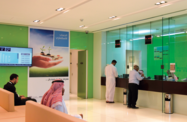High levels of client confidence and strong economic growth are expected to drive banking sector expansion in Saudi Arabia this year and beyond, with lending activity projected to rise to match increasing demand from both consumers and businesses.
According to the results of a survey released in early March by professional services firm Ernst & Young, 53% of Saudis have complete trust in their primary financial service providers, far above the global average of 44%. Respondents to the survey said issues such as confidentiality, reputation and pricing of services were among the key factors in building confidence. Nearly 70% said their trust in banks had improved since 2012, when the last study was conducted.
The positive results came in the wake of a strong year for Saudi banks. The 12 major lenders saw profits rise by 7.18% in 2013, while combined assets expanded by more than 9%, to total $498.7bn, and deposits increased by 10% to $389.3bn. Credit growth was robust, with loans up 12.41% over the previous year.
Despite the increase in lending activity, asset quality remains high, ratings agency Fitch wrote in an early 2014 report, attributing this to better underwriting standards, a stable operating environment, and new loans directed mainly towards government-related projects.
On the funding side, Fitch said Saudi banks benefit from easy access to low-cost deposits, alleviating margin pressures. However, the report pointed out that, given the increase in long-term lending, banks may well benefit from alternative sources of funding to alleviate any asset-liability maturity mismatches.
Loan portfolios to expand
The outlook for 2014 is for continued strong growth in lending, according to a report from Moody’s published in early March. The ratings agency said credit growth could reach up to 15% this year, second in the region only to Qatar. While Moody’s said the increase in lending would help stimulate economic development, the report warned that high levels of credit could feed into inflation.
For now, however, that risk seems small. The pace of consumer inflation eased in February to 2.8% year-on-year, the lowest rate in 17 months. In March, the governor of the Saudi Arabian Monetary Agency (SAMA), Fahad Al Mubarak, said the IMF’s inflation forecast for the Kingdom this year – at 3% – is “reasonable”.
Al Mubarak said he did not see any major risks for the Saudi economy in the coming year, with its low interest rates likely to remain in place for some time to come. SAMA has kept its repo rate at 2% since the beginning of 2009.
Tourism sector tipped for increased lending demand
One sector that could provide opportunities for commercial lending this year and beyond is tourism. According to official forecasts issued in mid-March, the tourism industry will post rapid expansion over the coming seven years, as the government looks to expand resort and holiday options, as well as business and conference trade.
This would require significant investments, which could be financed in part by local banks. In January, the Saudi Commission for Tourism and Antiquities (SCTA) signed agreements with government-owned financial institutions, such as the Saudi Credit and Savings Bank and Saudi Industrial Development Fund, to improve access to financing for tourism projects. At the same time, the SCTA said it was working with the Ministry of Finance to set up a mechanism for long-term leasing at tourism locations to facilitate private investment.
A test of public sentiment toward the banking sector will come late this year, with the government announcing at the end of February it intends to sell off a 15% holding in the National Commercial Bank, the country’s largest lender by assets. The plan for the initial public offering will be finalised in the third quarter, according to Finance Minister Ebrahim Al Assaf.
Interest in the partial float is expected to be high, reflecting the bank’s strong position in the market, with assets of more than $100bn and net profits of $2.1bn in 2013.
Follow Oxford Business Group on Facebook, Google+ and Twitter for all the latest Economic News Updates. Or register to receive updates via email.

